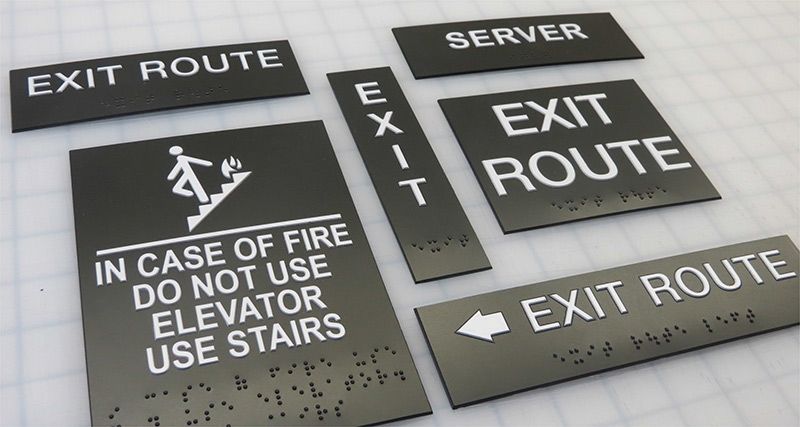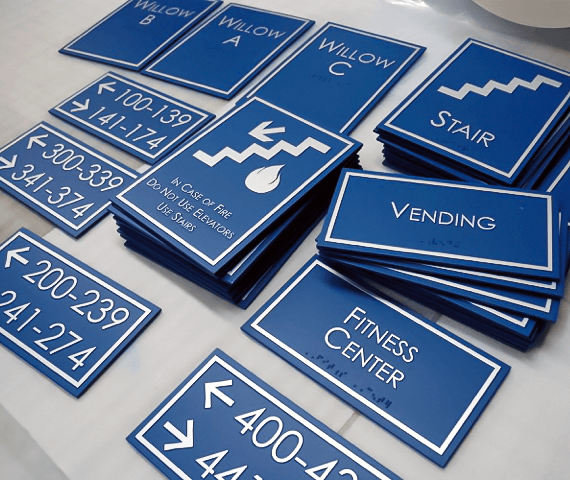Discovering Imaginative Layouts for Reliable ADA Signs
Discovering Imaginative Layouts for Reliable ADA Signs
Blog Article
Discovering the Secret Attributes of ADA Indicators for Boosted Access
In the realm of access, ADA indicators function as quiet yet powerful allies, ensuring that rooms are accessible and comprehensive for people with disabilities. By incorporating Braille and responsive aspects, these indications damage obstacles for the aesthetically impaired, while high-contrast color design and clear font styles accommodate varied aesthetic requirements. Their tactical placement is not approximate but instead a calculated effort to promote seamless navigating. Past these functions lies a much deeper narrative concerning the evolution of inclusivity and the ongoing commitment to producing equitable areas. What more could these signs represent in our search of universal accessibility?
Value of ADA Compliance
Making sure conformity with the Americans with Disabilities Act (ADA) is crucial for cultivating inclusivity and equivalent gain access to in public spaces and work environments. The ADA, passed in 1990, mandates that all public facilities, employers, and transport solutions accommodate individuals with specials needs, guaranteeing they enjoy the very same rights and chances as others. Conformity with ADA criteria not only satisfies legal responsibilities however additionally boosts a company's credibility by showing its dedication to variety and inclusivity.
Among the vital aspects of ADA compliance is the application of easily accessible signs. ADA signs are developed to make sure that people with specials needs can conveniently browse via spaces and structures. These indications need to abide by particular guidelines relating to dimension, typeface, shade comparison, and positioning to assure visibility and readability for all. Properly implemented ADA signage helps get rid of obstacles that individuals with handicaps usually run into, therefore advertising their self-reliance and confidence (ADA Signs).
In addition, adhering to ADA laws can minimize the danger of possible penalties and legal effects. Organizations that stop working to adhere to ADA standards may encounter claims or penalties, which can be both destructive and financially burdensome to their public photo. Thus, ADA conformity is integral to fostering a fair environment for everybody.
Braille and Tactile Elements
The unification of Braille and responsive aspects into ADA signage personifies the principles of accessibility and inclusivity. These attributes are vital for individuals who are blind or aesthetically damaged, allowing them to navigate public areas with higher self-reliance and self-confidence. Braille, a tactile writing system, is necessary in providing composed information in a style that can be conveniently perceived with touch. It is normally placed underneath the equivalent text on signage to make sure that people can access the information without visual help.
Responsive aspects prolong past Braille and consist of increased personalities and icons. These elements are created to be noticeable by touch, allowing people to determine space numbers, bathrooms, exits, and other crucial areas. The ADA establishes certain standards pertaining to the dimension, spacing, and placement of these tactile elements to maximize readability and make sure consistency across various atmospheres.

High-Contrast Shade Plans
High-contrast color pattern play a critical duty in boosting the presence and readability of ADA signage for people with visual problems. These systems are essential as they maximize the distinction in light reflectance between text and background, ensuring that indicators are quickly noticeable, also from a range. The Americans with Disabilities Act (ADA) mandates the use of details color contrasts to suit those with limited vision, making it a critical element of compliance.
The efficiency of high-contrast colors hinges on their capability to stand apart in numerous lighting problems, consisting of dimly lit settings and areas with glare. Commonly, dark text on a light background or light message on a dark background is utilized to attain optimal contrast. For circumstances, black message on a white or yellow history gives a stark visual difference moved here that helps in fast acknowledgment and comprehension.

Legible Fonts and Text Dimension
When considering the design of ADA signs, the selection of understandable typefaces and proper message size can not be overstated. The Americans with Disabilities Act (ADA) mandates that fonts must be not italic and sans-serif, oblique, script, highly attractive, or of uncommon type.
The size of the text also plays a pivotal duty in access. According to ADA standards, the minimum text height should be 5/8 inch, and it should raise proportionally with checking out distance. This is additional hints specifically vital in public rooms where signage requirements to be read quickly and properly. Consistency in text size adds to a cohesive aesthetic experience, helping individuals in browsing settings effectively.
Furthermore, spacing in between letters and lines is indispensable to clarity. Appropriate spacing avoids personalities from appearing crowded, boosting readability. By adhering to these requirements, developers can substantially improve availability, ensuring that signage offers its intended purpose for all individuals, despite their aesthetic capacities.
Efficient Positioning Approaches
Strategic positioning of ADA signs is vital for making the most of accessibility and making certain compliance with legal requirements. Appropriately positioned signs assist people with specials needs properly, facilitating navigating in public areas. Key considerations consist of proximity, presence, and elevation. ADA standards stipulate that indications should be placed at an elevation between 48 to 60 inches from the ground to guarantee they are within the line of sight for both standing and seated individuals. This conventional elevation variety is important for inclusivity, making it possible for wheelchair individuals and people of differing heights to gain access to info easily.
Additionally, indicators must be positioned nearby to the lock side of doors to enable very easy identification before entry. Uniformity in sign placement throughout a facility boosts predictability, minimizing confusion and boosting overall customer experience.

Conclusion
ADA signs play a vital role in promoting accessibility by integrating functions that attend to the requirements of individuals with impairments. These aspects jointly foster an inclusive atmosphere, highlighting the relevance of ADA compliance in making certain equal gain access to for all.
In the world of availability, ADA indications serve as quiet yet powerful allies, guaranteeing that areas are navigable and inclusive for people with handicaps. The ADA, established in 1990, mandates that all public facilities, employers, and transport services accommodate individuals with disabilities, guaranteeing they appreciate the exact same rights and possibilities as others. ADA Signs. ADA indicators are designed to make certain that individuals with disabilities can conveniently navigate via spaces and structures. ADA guidelines stipulate that indications should be mounted at an elevation between 48 to 60 inches from the ground to guarantee they are within the line of sight for both standing and seated people.ADA signs play an essential duty in advertising ease of access by incorporating functions that resolve the requirements of people with impairments
Report this page